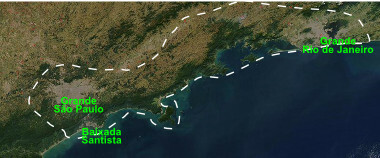megalopolis is a term elaborated to designate a super-urbanized region or area, which gathers around itself an articulation between metropolises, metropolitan regions and small cities, concentrating much of the population and services of a parents. The expression was created in 1960 by the French geographer Jean Gottmann (1915-1994) to classify the region of the United States that involved the cities of Boston, Washington D. Ç. and New York.
It is important to understand that the megalopolis concept it does not only involve the space of a city or its population or even the urban interconnection of a metropolitan region. In other concepts, such as metropolis, we find more specific designations aimed at the degree of complexity or the amount of urban population. However, in the term "megalopolis", there is the involvement of a region or area that encompasses not only several large cities, but a complex economic, social and cultural connection, a complexity that is responsible for constituting a dense urban network.
O term megalopolis is often confused with the concept of megacity. However, these expressions designate totally different issues, given that the second refers to a city with more than 10 million inhabitants.
In Brazil, there is a megalopolis involving a large area that goes from Greater São Paulo to Greater Rio de Janeiro, passing through the Baixada Santista and Vale do Paraíba regions. It is a densely urbanized and industrialized area that, despite involving only 0.5% of the national territory, concentrates 23% of the population and a good part of the wealth produced by the country.
Do not stop now... There's more after the advertising ;)

Location of the Rio-São Paulo Megalopolis, in the Southeast region of the country
In the United States alone there are three megalopolises, but it is in Japan that the largest of them can be found. It extends from Tokyo to the city of Kitakyushu, also encompassing the metropolis of Osaka. This megalopolis is home to more than 80% of the Japanese population and around 85% of the country's industries, forming one of the most densely urbanized centers on the entire planet.
It is important to remember, however, that these areas are not just made up of urban activities and practices. There are also rural spaces, with intensive agricultural activities, generally constituted by advanced technologies and an intense process of mechanization, in what is known as agroindustry.
Megalopolises can be considered as the most flagrant spatial expression of the process of globalization and diffusion of the Technical-Scientific Revolution Informational, revealing how techniques and technologies contribute to transform human actions in the production process of geographic space.
By Me. Rodolfo Alves Pena
Would you like to reference this text in a school or academic work? Look:
PENA, Rodolfo F. Alves. "What is Megalopolis?"; Brazil School. Available in: https://brasilescola.uol.com.br/o-que-e/geografia/o-que-e-megalopole.htm. Accessed on June 28, 2021.

